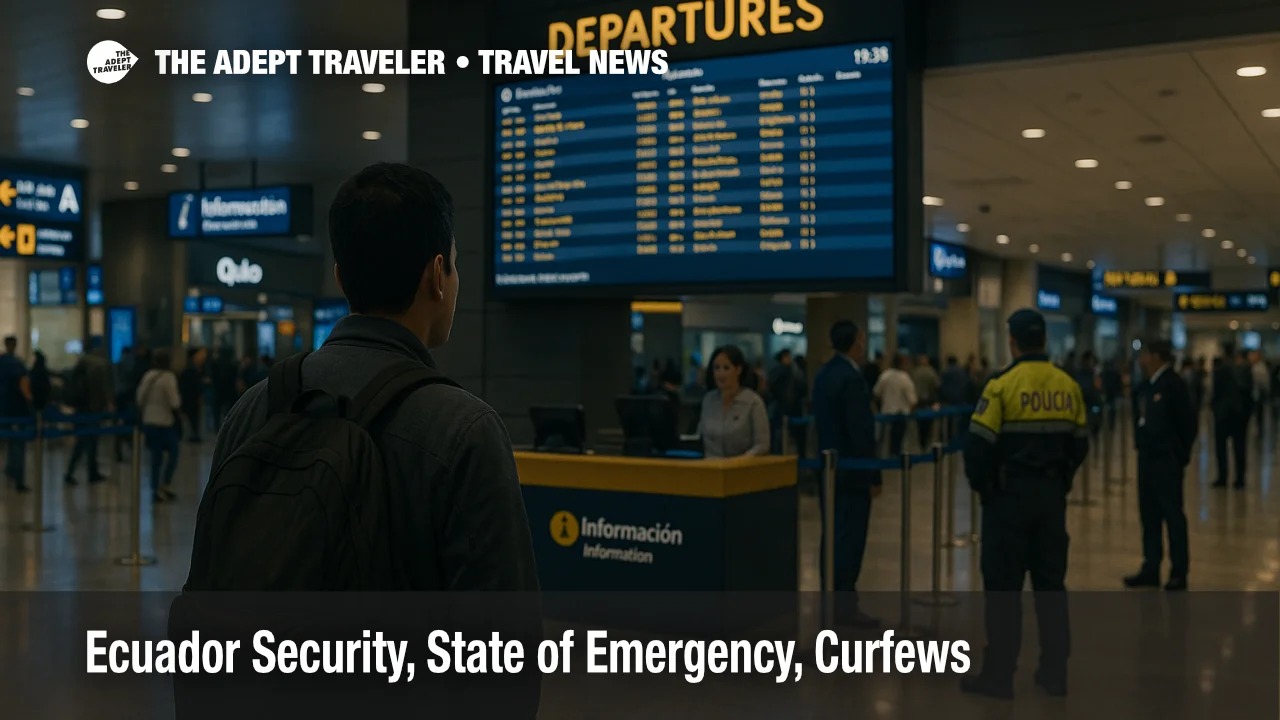Ecuador Security, State of Emergency, Curfews

Key points
- Select provinces and municipalities in Ecuador are under an active state of emergency with night curfews
- Security operations and protests can trigger short notice restrictions on movement and public gatherings
- Expect intermittent road checkpoints, transit detours, and tighter screening at Quito and Guayaquil airports
- U.S. Embassy alerts and partner government advisories emphasize monitoring local guidance and news
- Measures are part of an ongoing internal security campaign targeting organized criminal groups
Impact
- Curfew Windows
- Verify local curfew hours by province or canton before evening travel and adjust plans accordingly
- Affected Regions
- Confirm whether your destination is currently under an emergency decree or municipal order
- Airport Transfers
- Build extra buffer time for late day or night runs to Quito Mariscal Sucre International Airport and José Joaquín de Olmedo International Airport
- Ground Transport
- Expect police and military checkpoints, possible detours, and pauses on intercity routes, carry ID at all times
- What To Do
- Monitor municipal channels and embassy alerts, avoid protests even if peaceful, and follow all security instructions
Ecuador's security posture remains elevated, with rolling states of emergency and localized curfews applied in several provinces and municipalities as authorities continue operations against organized crime. Orders can start, shift, or expire at short notice, and enforcement varies by location, so travelers should verify conditions for their exact route and departure times, including late evening airport transfers.
Situation overview
The government has repeatedly used emergency decrees since early 2024 alongside an internal armed conflict designation, enabling expanded security operations and curfews in targeted areas. These tools have been renewed in response to spikes in gang violence, prison unrest, and periodic civil demonstrations, which can affect movement in cities as well as intercity corridors. Current alerts from diplomatic missions stress that the risk environment can change quickly, and that curfew windows and affected districts are not uniform nationwide.
For travelers, the practical effect is variability. Some districts may see a 1000 p.m. to 500 a.m. curfew, others may have shorter windows or no curfew at all during a given week. Checkpoints can appear on arterial roads in and out of major cities, which can add time to airport transfers or intercity bus legs. When protests occur, authorities may restrict public gatherings, close select streets, or pause transit lines temporarily, which complicates last mile plans even if airports remain open.
Airports and transfers
On first mention, Quito Mariscal Sucre International Airport (UIO) and José Joaquín de Olmedo International Airport (GYE) are operating, however the path to and from the terminal can be the pinch point under curfew or protest conditions. If you have late evening departures or arrivals, build in extra time for screening and potential detours, carry a printed or digital copy of your itinerary, and keep government issued photo ID accessible. When curfews apply, drivers may be asked to justify travel during restricted hours, and documentation helps. Always follow the instructions of police or military at checkpoints, stay inside the vehicle unless directed, and keep phones out unless explicitly asked to show documents.
Within cities, ride hail services can surge price or limit availability near protest zones, and hotel concierges may advise alternate pickup points. If traveling by intercity coach, ask the operator for any curfew related timetable adjustments the day of departure. Domestic flights are generally less affected than roads, but leave generous time to clear any roadblocks or rerouting on airport approaches.
What is changing and why it matters
Ecuador's security campaign has included periodic prison transfers and high visibility enforcement actions intended to break gang command and control, steps that have sometimes followed, or preceded, spikes in violence. These moves can be followed by short term changes in curfew geography or enforcement tempo, which is why embassy alerts and local municipality feeds are important day to day. Treat curfew maps as dynamic and recheck the status for your province or canton on the day you travel.
If demonstrations are announced, avoid the area, even if they appear peaceful. Routes to airports, coach terminals, and popular tourist areas can be disrupted without much notice. In past waves, authorities have imposed curfews, limited assemblies, and conducted vehicle checks to keep essential corridors open. The advisories for U.S. citizens remain at Exercise Increased Caution nationwide, with additional restrictions in specific areas, and they emphasize checking local orders before moving around after dark.
Background
Under Ecuadorian law, a state of emergency allows the executive to limit certain rights temporarily, including freedom of movement and assembly, and to deploy the military to support police. Since January 2024, these tools have been used repeatedly in response to gang activity, prison crises, and, at times, protest related unrest. In 2025, renewed decrees covered multiple coastal provinces and select municipalities in the interior, with curfews set by local order. While these measures have contributed to periods of reduced homicides, they also create operational uncertainty for travelers, which is why planning buffers and on the day checks are essential.
Final thoughts
The headline for travelers is simple, curfews and emergency rules can change quickly by district, so confirm them the same day you move, then add time to airport and intercity transfers. Keep identification and itineraries accessible, follow instructions at checkpoints, and avoid protest areas entirely. With active monitoring and a little extra margin, most trips can proceed as planned under Ecuador's current security posture.
Sources
- Alert for U.S. Citizens, State of Emergency in Seven Provinces
- Security Alert, Continued Violence and Security Operations in Ecuador
- Ecuador Travel Advisory, U.S. Department of State
- Ecuador's President Declares New State of Emergency in 7 Regions
- Ecuador Transfers 300 High Risk Inmates to New Maximum Security Prison
- Ecuador Travel Advice, Smartraveller
